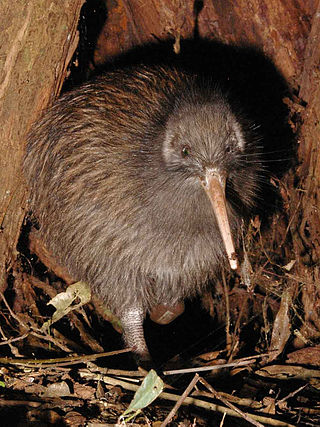
Kiwi are flightless birds endemic to New Zealand of the order Apterygiformes. The five extant species fall into the family Apterygidae and genus Apteryx. Approximately the size of a domestic chicken, kiwi are the smallest ratites.

The southern brown kiwi, tokoeka, or common kiwi is a species of kiwi from South Island, New Zealand. Until 2000 it was considered conspecific with the North Island brown kiwi, and still is by some authorities.

The great spotted kiwi, great grey kiwi or roroa is a species of kiwi endemic to the South Island of New Zealand. The great spotted kiwi, as a member of the ratites, is flightless. It is the largest of the kiwi. The rugged topography and harsh climate of the high altitude alpine part of its habitat render it inhospitable to a number of introduced mammalian predators, which include dogs, ferrets, cats, and stoats. Because of this, populations of this species have been less seriously affected by the predations of these invasive species compared to other kiwi. Nonetheless, there has been a 43% decline in population in the past 45 years, due to these predators and habitat destruction. This has led it to be classified as vulnerable. There are less than 16,000 great spotted kiwis in total, almost all in the more mountainous parts of northwest Nelson, the northwest coast, and the Southern Alps. A minority live on island reserves.

The little spotted kiwi or little grey kiwi is a small flightless bird in the kiwi family, Apterygidae. It is the smallest of the five kiwi species, at about 0.9 to 1.9 kg, about the size of a bantam. It is endemic to New Zealand, and in pre-European times occurred in both main islands, but is now restricted to a number of small offshore islands, and mainland reserves protected by pest-exclusion fences.

The Okarito kiwi, also known as the rowi or Okarito brown kiwi, is a member of the kiwi family Apterygidae, described as new to science in 2003. The species is part of the brown kiwi complex, and is morphologically very similar to other members of that complex. It is found in a restricted area of the Ōkārito forest on the West Coast of New Zealand's South Island, and has a population of only about 600 birds.

The North Island brown kiwi is a species of kiwi that is widespread in the northern two-thirds of the North Island of New Zealand and, with about 35,000 remaining, it is the most common kiwi. It holds the world record for laying the largest eggs relative to its body size.

The Haast tokoeka or Haast kiwi is a putative subspecies of the southern brown kiwi. It is one of the rarest kiwi in New Zealand. Like other kiwi, this bird is flightless.

Apterygon is a genus of louse. It is endemic to New Zealand and is an ectoparasite of kiwi birds (Apteryx). Theresa Clay circumscribed the genus in 1961. In 1947, she had referred to this genus as "New Genus D", but it was not formally named as she needed to confirm the host of her specimen as well as additional material.
Freyanidae is a family of feather mites in the order Astigmata. There are more than 15 genera in Freyanidae.

Kiwalges haastii is a species of New Zealand feather mite in the superfamily Analgoidea, known only from the great spotted kiwi, from which it derives its name.
Eustathiidae is a family of mites belonging to the order Sarcoptiformes.
Xolalgidae is a family of mites belonging to the order Sarcoptiformes.
Psoroptoididae is a family of mites belonging to the order Sarcoptiformes.
Pterolichidae is a family of mites belonging to the order Sarcoptiformes.
Alloptidae is a family of mites belonging to the order Sarcoptiformes.
Ptyssalges is a monotypic genus of mites belonging to the monotypic family Ptyssalgidae. The only species is Ptyssalges major.
The Fiordland tokoeka or Fiordland kiwi is a subspecies of southern brown kiwi. It is endemic to New Zealand. Like other ratites, it is flightless.

The Stewart Island tokoeka, Stewart Island kiwi, Rakiura tokoeka or Rakiura kiwi is a subspecies of southern brown kiwi endemic to New Zealand. Like other ratites, it is a flightless bird.
Ixodes anatis, also called the kiwi tick, is a species of tick in the arthropod family Ixodidae. It is endemic to New Zealand and mainly parasitizes kiwi.








